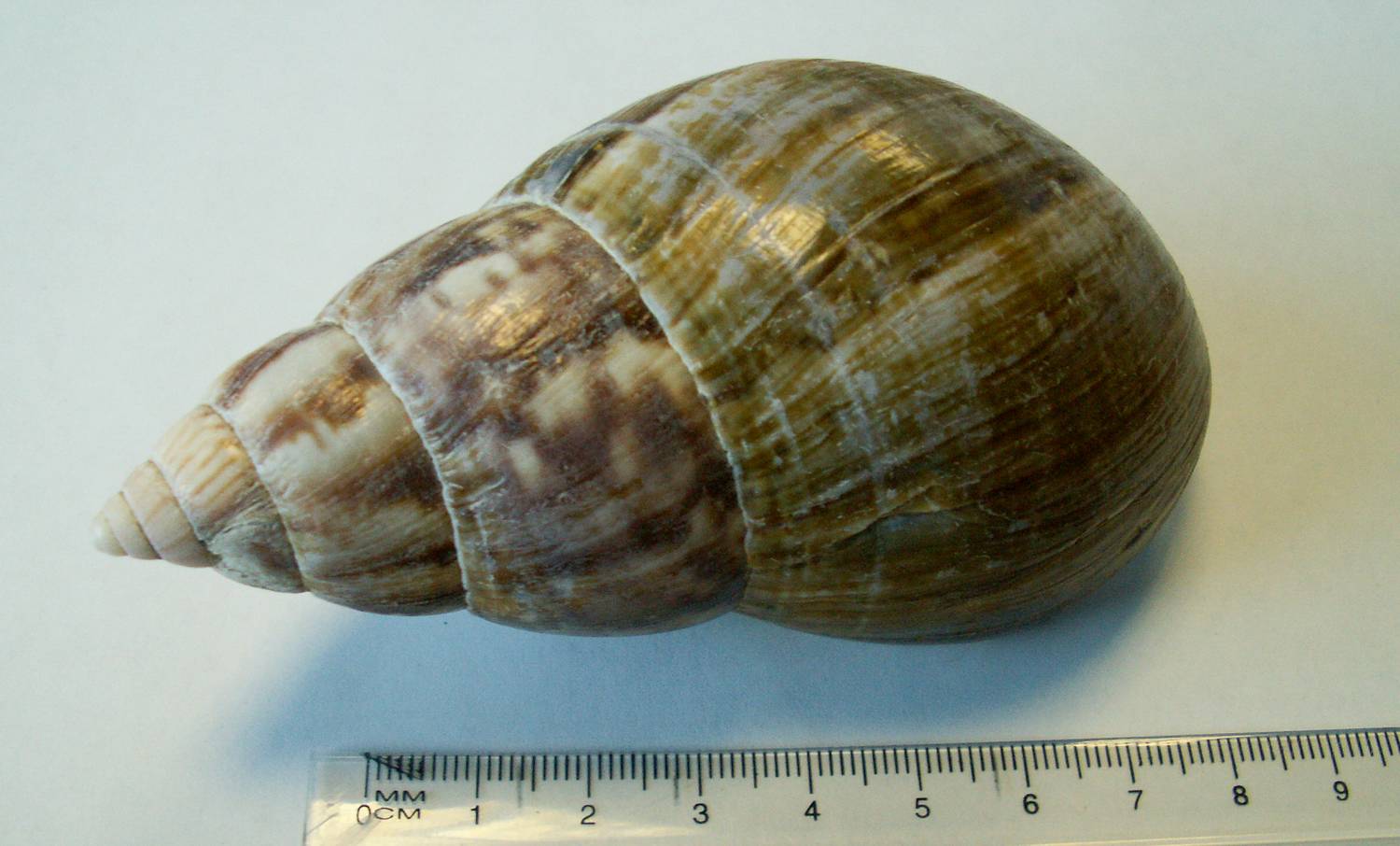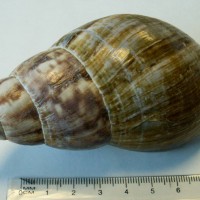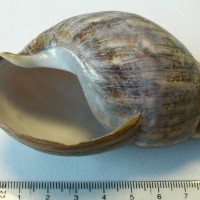
Giant African Land Snail - Achatina fulica
Expand and collapse the sections below by clicking on the title or + / - icons.
Short description of Achatina fulica, Giant African Land Snail
Shell relatively long, narrow and conical, and up to 20cm long (more commonly 5-10cm in the wild). Shell variable in colour, usually light brown with darker brown and cream banding. Nocturnal. Coarse tubercles.
Impact summary: Achatina fulica, Giant African Land Snail
Impacts on native plant species through herbivory. Alters nutrient cycling. Competes with native gastropods. Indirect effects on non-target species through control efforts.
Habitat summary: Achatina fulica, Giant African Land Snail
Not recorded in the wild in GB. In introduced areas it is found in a wide variety of habitats, often in association with human activities.
Overview table
| Environment | Terrestrial |
|---|---|
| Species status | Non-Native |
| Native range | Ethiopia, Kenya, Tanzania |
| Functional type | Herbivore |
| Status in England | |
| Status in Scotland | |
| Status in Wales | |
| Location of first record | |
| Date of first record | Unknown |
Origin
East Africa, especially Kenya and Tanzania - now effectively pantropical due to widespread introductions.
First Record
Not introduced to GB in the wild, but sometimes kept as a pet.
Pathway and Method
Kept as a pet (most are bred in GB rather than being imported), but although there may be releases of unwanted individuals it is not yet established.
Species Status
Though not found in the wild in GB, highly invasive in many countries. Particularly widely introduced to Asia, the Caribbean and Pacific islands.
Dispersal Mechanisms
Accidental transportation of small snails and eggs with agricultural, horticultural, and other commercial products and their containers; also introduced for ornamental purposes, as a novelty pet, and as a food resource for humans and (less often) animals . Escapes and intentional releases have led to introductions in some locations e.g. in parts of Asia . It may also be smuggled as food, medicine or ornamental use.Although terrestrial, it is able to spread on floating vegetation/debris or sometimes on the water surface of rivers as has occurred in Brazil.Local natural dispersal occurs with individual snails travelling up to 50 metres overnight. In New Caledonia the snails were found to move an average of 250m per year and 125m per month has been suggested for natural dispersal, particularly in wet weather.
Reproduction
Giant African land snails are obligate out-crossing hermaphrodites, hence one externally fertilised snail can establish a population; the snail's ability to store sperm is a distinct advantage and could enable a founding population to form from just one individual. Eggs are large (4.5-5.5mm in diameter) and only hatch at temperatures above 15°C. Egg-laying begins at six months of age and fecundity lasts approximately 400 days. Up to 100 eggs are laid in the first year and up to 500 in the second year; fecundity declines after the second year, but snails may have a total egg production of up to 1000 over five years, with some individuals reported as living for nine years.
Known Predators/Herbivores
Though it is likely that the snails are taken by predators, there is little information on species that target them.
Resistant Stages
Nocturnal, spending the day buried underground or otherwise sheltered. It can aestivate for up to three years in times of extreme drought, sealing itself into its shell by secreting of an impermeable calcareous compound that dries on contact with air.
Habitat Occupied in GB
Not recorded in the wild. In introduced areas it is found in a wide variety of habitats, often in association with human activities. Wherever it occurs, the snail keeps to hot lowlands and warm temperate lower slopes. It needs temperatures well above freezing all year, and high humidity during at least part of the year; drier months are spent in aestivation. It is a generalist herbivore eating a wide range of plant material, fruit and vegetables. It will sometimes eat sand, very small stones, bones from carcasses and even concrete as calcium sources for its shell.
Not recorded in the wild in GB.
Environmental Impact
Impacts on native plant species through herbivory, altered nutrient cycling, competition with native gastropods and indirect effects on non-target species through efforts to control giant African land snails.
Health and Social Impact
Giant African land snails can be a general nuisance when found near human habitations as well as posing a hazard to drivers when found at high densities, causing cars to skid. Decaying snails also release a bad odour, and the calcium carbonate in their shells neutralises acid soils, altering soil properties and the types of plants that can be grown.
It has economic importance as a protein source with considerable amounts of giant African land snail meat exported to Europe and America from Taiwan, China and other Asian countries. Interest in the giant African land snail as an edible snail has lead to its establishment in regions of Brazil, while it is also raised as a laboratory animal. As a vector of the rat lungworm which causes eosinophilic meningitis in man, they should only be eaten if properly prepared, (thoroughly cleaned after a fast of several days, and cooked for at least one hour), and snails that have been in contact with molluscicides should never be eaten. It is advisable to wash hands after handling uncooked snails.
Economic Impact
Giant African land snail distributes spores of Phytophthora palmivora in its faeces in Ghana; P. palmivora causes black pod disease of cacao (Theobroma cacao) which also infects black pepper, coconut, papaya and vanilla. This snail also spreads P. colocasiae in taro (Colocasia esculenta) and P. parasitica in aubergine (Solanum melongena) and tangerine (Citrus reticulata).
Giant African land snails are considered one of the worst snail pests of tropical and subtropical regions. Individually, their small size limits the quantity of plant material consumed per animal but infestations can lead to severe damage. However, the process of naturalisation may lessen the impacts after initial invasion.
Agricultural impacts are as follows, noting that seedling/nursery stages of crops are most vulnerable, with type and severity of damage varying by species in mature plants:
Loss of crop yield caused by herbivory.Spread of plant pathogens.Costs associated with pest control.Cost of opportunity loss due to enforced changes in agricultural practice such as limiting crops being grown to those resistant to snail infestation.
In Florida it has been estimated that giant African land snails would have caused an annual loss of $11 million in 1969 if its population had not been controlled (ISSG 2010). More recently in the USA, elimination ofthis snail varied in cost from $60,000 to $700,000 with scrub clearance costing approximately $3300 per month for one municipality (Smith & Fowler 2003).
Identification
Walker, K. (2007) Giant African Snail (Achatina fulica), Pest and Diseases Image Library. [accessed 18/03/2011].
Biology, ecology, spread, vectors
ISSG database (2010) Achatina fulica ecology. [accessed 18/03/2011].
Mead, A. R. (1979) Pulmonates volume 2B. Economic Malacology with Particular Reference to Achatina fulica. Academic Press, London. [This is an update of the 1961 version available as a download here].
Raut, S.K. & Barker, G.M. (2002) Achatina fulica Bowdich and Other Achatinidae as Pests in Tropical Agriculture. In: Barker, G.M. (ed.) Molluscs as Crop Pests. CABI, Wallingford.
Smith, J.W. & Fowler, R.G. (2003) Pathway Risk Assessment for Achatinidae with emphasis on the Giant African Land Snail Achatina fulica (Bowdich) and Limicolaria aurora (Jay) from the Caribbean and Brazil, with comments on related taxa Achatina achatina (Linne), and Archachatina marginata (Swainson) intercepted by PPQ. USDA-APHIS, Center for Plant Health Science and Technology, Raleigh NC (Internal Report).
Mead, A. R. 1979. Pulmonates volume 2B. Economic malacology with particular reference to Achatina fulica. London, Academic Press.
Management and impact
Gerlach, J. (2001) Predator, prey and pathogen interactions in introduced snail populations. Animal Conservation, 4, 203-209.
Meyer, W.M. & Shiels, A.B. (2009) Black Rat (Rattus rattus) predation on nonindigenous snails in Hawai‘i: Complex management implications. Pacific Science, 63(3), 339-347.
Prasad, G.S., Singh, D.R., Senani, S. & Medhi, R.P. (2004) Eco-friendly way to keep away pestiferous Giant African snail, Achatina fulica Bowdich from nursery beds. Current Science, 87(12), 1657-1659.
General
Lambert, M. (1999) Pest Advisory Leaflet no. 6: Giant African Snail (3rd ed.). Pacific Plant Protection Service of the Secretariat of the Pacific Community, Suva.
USDA–APHIS (2005) New Pest Response Guidelines. Giant African Snails: Snail Pests in the Family Achatinidae. USDA–APHIS–PPQ–Emergency and Domestic Programs–Emergency Planning, Riverdale, Maryland.
Spotted this species?
Distribution map

Native range map
View an interactive native range map for Giant African Land Snail, Achatina fulica


